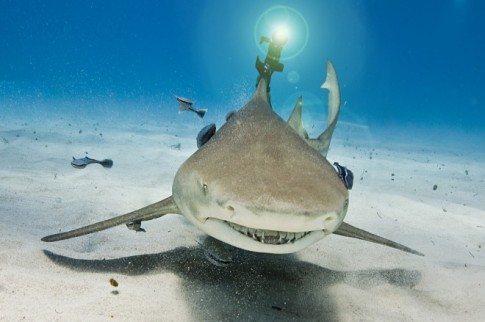Finally, a Shark With a Laser
Relax, Dr Evil. Your inspired request for “sharks with frickin’ laser beams attached†has finally been fulfilled in the real world. Yes, it’s time for you to lay awake in bed at night and run the permutations over & over in your head about just how this will effect your self-esteem levels next time you pay a visit to open water. In short it’s frikking scary.
Marine biologist-cum-TV personality Luke Tipple attached a 50-milliwatt green laser to a lemon shark off the coast of the Bahamas in late April. The escapade was sponsored by Wicked Lasers, a consumer-focused laser manufacturer based in Hong Kong that produces some of the most brilliant — and potentially dangerous — handheld lasers in the world.
“This was definitely a world first,†Tipple told Wired. “Initially, I told them no. I thought it was a frivolous stunt. But then I considered that it would give us an opportunity to test our clips and attachments, and whatever is attached to that clip, I really don’t care. It was a low-powered laser that couldn’t be dangerous to anyone, and there’s actually useful applications in having a laser attached to the animal.â€
Tipple said the experiment was instructive in a number of ways. For starters, he was able to further test his clamping apparatus, which is typically used for traditional data-aquisition equipment.
He also wanted to verify anecdotal evidence that sharks avoid laser energy of specific spectrums and wavelengths. Curiously, at least with the Wicked Lasers model, he found the opposite to be true: “Although further testing is necessary, time and time again, sharks were actually attracted to the laser beam,†he said.
Finally, he said the experiment was helpful in measuring a shark’s velocity and trajectory in real time. “We were able to see how their body positioning relates to a target,†he said. “You can get a very clear description, via the laser, of what the shark’s body is doing.â€
Other experts find the Wicked Lasers stunt of dubious value, and we’ll get to those criticisms soon. But for now, let’s describe exactly what went down in the Caribbean on Apr. 24.
Wicked Lasers supplied Tipple with the lowest-powered version of its S3 Krypton green laser. Where a simple laser pointer might generate a beam measuring about 2mW in power, the shark-deployed model, operating on its low-power setting, emitted a beam in the neighborhood of 50mW. This isn’t a beam that can be safely shined in anyone’s eye, but it’s nowhere near as dangerous as the 1-watt Krypton model Gadget Lab tested in October 2011.

Tipple says the laser was attached to a lemon shark’s dorsal fin via a “non-invasive clamp†applied by a diver to ensure correct positioning. Tipple says he chose a lemon shark — Negaprion brevirostris — for its “predictable and relatively docile swimming behavior during the day, ease of access in shallow water, and size of the dorsal fin.â€
In other words, the shark was easily corralled and size-appropriate, and probably wouldn’t stray very far during the stunt. And, indeed, Tipple’s team was able to retrieve the host shark by the end of the experiment, and remove the clamp.
“The clamp has specially designed gel pads on the inside of its jaws that create a tactile surface interaction with the dermal denticles of the sharks skin, so basically it doesn’t move,†Tipple says. “Zinc elements of the spring device within the clamp are designed to corrode and would lessen the grip of the clamp within a week. In around a month, the spring would be rendered useless, causing the clamp to simply fall off.â€
So how did the shark respond to its evil laserfication?
“The shark didn’t really like it when I initially deployed the clamp,†says Tipple, “but after a few seconds it returned to normal behavior. The clamp itself isn’t strong enough to cause any pain, and the dorsal fin is actually not very sensitive due to it being composed primarily of cartilage.â€
During our interview, Tipple went to great lengths to explain that neither the shark, nor Caribbean sea life, nor his team of divers were at ever at risk from the laser. “The laser we were using wasn’t strong enough to cause ocular or thermal damage to other sea life,†he says.
What’s more, his credentials as an animal rights advocate are strong. He holds a degree in marine biology from James Cook University, and is the managing director of the Shark-Free Marina Initiative, an organization dedicated to lowering worldwide shark mortality rates.
Granted, these bona fides are tempered by Tipple’s status as a celebrity shark handler — he’s appeared on Mythbusters and various Discovery Channel “Shark Week†shows, among other TV appearances. It all begs the question: What’s the real value of attaching a laser to a shark, other than to generate publicity for Tipple himself, and the Wicked Lasers brand, which organized a Facebook promotion around the stunt?
“Is there a point of it? It has to have an objective,†Neil Hammerschlag, an assistant professor with the Rosenstiel School of Marine and Atmospheric Science, told Wired.
“I would say the attachment process sounds non-invasive,†Hammerschlag said. “I don’t think it’s going to cause any damage to the shark. It’s temporary. In terms of the goal, without knowing the specific scientific or educational application, it’s hard to say. But if this is just to respond to a scene in the Austin Powers movie, I don’t see value. You’re just causing unnecessary stress on the animal. It’s not respectful.â€
Sean Van Sommeran, executive director and founder of the Pelagic Shark Research Foundation, said he was interested in Tipple’s efforts to build a better fin clamp. “I like the idea of the spring-loaded hinge that’s going to break down over time in the salt water,†Van Sommeran told Wired. “It’s a good alternative to drilling holes through the fins. Sharks are slow growing so something attached temporarily, for even a month, isn’t necessarily going to harm the shark, or impede its growth.â€
Still, Van Sommeran said, were the shark to be armed with a laser for an extended period of time, the animal would find its new life in the sea quite challenging.
“The animal would essentially be carrying a roof rack of lights, atracting attention as it swims around,†he said. “Any time the animal goes deep into the water column, it will be more apparent. Predators can notice and take interest. Hammerhands might eat that lemon with a laser on it. And animals that the lemon may want to stalk can see it coming.â€
But even serious hardcore shark experts like Van Sommeran can relish in the bold absurdity of a laser-equipped shark: “Everything tilts toward this being a disadvantage for the shark. Its laser might blind a pilot and piss off the FAA. Or North Korea might counter-attack it,†he said.
And, of course, Wicked Lasers, the instigator of Tipple’s stunt, can’t help but have fun with the evil implications of laser-weaponized sharks.
“Depending on the power of the laser that they are armed with, the sharks could be significantly more dangerous,†Steve Liu, Wicked Lasers CEO, told Wired. “If there was a way the shark could operate the laser on its own accord and use it against humans, we wouldn’t even attempt this.â€




Comments